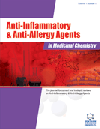- Home
- A-Z Publications
- Anti-Inflammatory & Anti-Allergy Agents in Medicinal Chemistry (Formerly Current Medicinal Chemistry - Anti-Inflammatory and Anti-Allergy Agents)
- Previous Issues
- Volume 11, Issue 2, 2012
Anti-Inflammatory & Anti-Allergy Agents in Medicinal Chemistry (Formerly Current Medicinal Chemistry - Anti-Inflammatory and Anti-Allergy Agents) - Volume 11, Issue 2, 2012
Volume 11, Issue 2, 2012
-
-
Application of Small Molecules/Macromolecules in Ocular Inflammatory Diseases
More LessAuthors: Baoying Liu, Chi-Chao Chan and Robert B. NussenblattMacrobiomolecular treatments for ocular inflammatory diseases have been described in a previous review. This article mainly discusses the application of small molecules in uveitis therapy, which includes corticosteroids, salicylic acid (aspirin), metabolite analogs, and anti-oxidative agents. Additionally, we update recent advances in peptide and nucleic acid related therapies, and focus mainly on the calcineurin inhibi Read More
-
-
-
A Novel Treatment Strategy for Sepsis and Septic Shock Based on the Interactions between Prostanoids, Nitric Oxide, and 20-Hydroxyeicosatetraenoic Acid
More LessSepsis is a systemic inflammatory response syndrome with a suspected or proven infection caused by any pathogen or a clinical syndrome associated with a high probability of infection. The definition of septic shock includes sepsis-induced hypotension despite adequate fluid resuscitation, along with the presence of organ perfusion abnormalities, and ultimately cell dysfunction. As the most common causes of Read More
-
-
-
Anti-Inflammatory Drugs and Prediction of New Structures by Comparative Analysis
More LessNonsteroidal anti-inflammatory drugs (NSAIDs) are a group of agents important for their analgesic, anti-inflammatory, and antipyretic properties. This study presents several approaches to predict and elucidate new molecular structures of NSAIDs based on 36 known and proven anti-inflammatory compounds. Based on 36 known NSAIDs the mean value of Log P is found to be 3.338 (standard deviation= 1.237), mean Read More
-
-
-
Increased Production of Nitric Oxide Mediates Selective Organ-Specific Effects of Endotoxin on Oxidative Stress
More LessEndotoxemic shock is a systemic inflammatory response that is associated with increased nitric oxide (NO) production by inducible NO synthase (iNOS) which contributes to hypotension, vascular hyporeactivity, and multiple organ failure. Oxidative stress (OS) is a major contributing factor to high morbidity and mortality in endotoxemic shock. We have previously demonstrated that endotoxin-induced fall in blood pressure is as Read More
-
-
-
Development of a Sensitive Cost-Effective Capture ELISA for Detection of Murine Monoclonal Antibodies - Correlation with SPR Biosensor Technology
More LessThe development of antibodies for diagnostic and therapeutic applications in inflammatory diseases is a major focus for biotechnology and pharmaceutical companies. Production of monoclonal antibodies requires the development of fast, high-throughput methodologies for screening and selecting appropriate candidate antibodies for development. Capture (sandwich) enzyme linked immunosorbent assay (ELISA) provi Read More
-
-
-
Novel Piperazinyl Derivatives with Anti-Hyperalgesic, Anti-Allodynic and Anti-Inflammatory activities Useful for the Treatment of Neuropathic Pain
More LessA series of structurally novel compounds possessing 2-phenylpiperazin-1-yl nicotinamide template was synthesized and evaluated for neuropathic pain activity. After the assessment of neurotoxicity and peripheral analgesic activity, the compounds were evaluated in a peripheral neuropathic pain model, the chronic constriction injury (CCI) to assess their antiallodynic and antihyperalgesic potential. Studies carried out to assess Read More
-
-
-
In Vitro Comparative Evaluation of Non-Leaves and Leaves Extracts of Andrographis paniculata on Modulation of Inflammatory Mediators
More LessAuthors: C. V. Chandrasekaran, B. Murali, M. Deepak and Amit AgarwalThis study was designed to evaluate and compare the inhibitory property of extracts of Andrographis paniculata leaves [methanolic (AP1), hydroalcoholic (AP2), successive water (AP3)] and non-leaves [methanolic (AP4), hydroalcoholic (AP5), successive water (AP6)] towards inflammatory mediators (NO, IL-1 beta, IL-6, TNF alpha, PGE2, TXB2 and LTB4). Stimulant induced J774A.1 murine macrophages and HL- Read More
-
Volumes & issues
-
Volume 24 (2025)
-
Volume 23 (2024)
-
Volume 22 (2023)
-
Volume 21 (2022)
-
Volume 20 (2021)
-
Volume 19 (2020)
-
Volume 18 (2019)
-
Volume 17 (2018)
-
Volume 16 (2017)
-
Volume 15 (2016)
-
Volume 14 (2015)
-
Volume 13 (2014)
-
Volume 12 (2013)
-
Volume 11 (2012)
-
Volume 10 (2011)
-
Volume 9 (2010)
-
Volume 8 (2009)
-
Volume 7 (2008)
-
Volume 6 (2007)
-
Volume 5 (2006)
Most Read This Month
Article
content/journals/aiaamc
Journal
10
5
false
en


